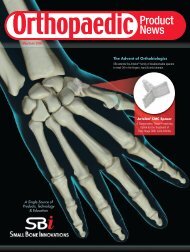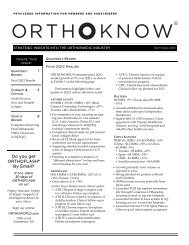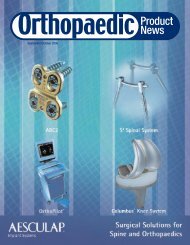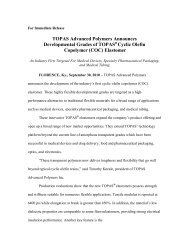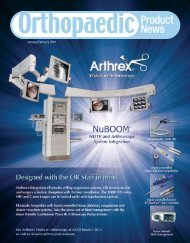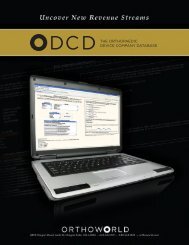Hip & Knee Surgery - Orthoworld
Hip & Knee Surgery - Orthoworld
Hip & Knee Surgery - Orthoworld
You also want an ePaper? Increase the reach of your titles
YUMPU automatically turns print PDFs into web optimized ePapers that Google loves.
FUTURETECHStandardized RadiographicDigital Imaging: A Cost EffectiveAlternative to CT and MRIAuthor: T. Derek V. Cooke, M.B., B.Chir., F.R.C.S.C.The advent of digital imaging has enhanced convenience andlowered costs of radiography, and the technology is rapidlybecoming universal.Two options currently exist. Computed radiography (CR) usesan imaging plate (phosphor-based) in place of film, which isscanned by laser to digitize the image. It has the advantages ofhigh sensitivity and resolution, with exposure compensation tomaximize contrast. Digital radiography (DR) employs a variety ofimaging plates with similar advantages to CR, but the image isinstantaneously captured digitally and displayed on a computermonitor. A central feature of both CR and DR is that they arereadily integrated into Picture Archiving Computer Systems(PACS) which manage image storage and retrieval.Despite its advantages (logistics, image sharpness, contrast,magnification, computerised metrics, etc.), digital image capturedoes not automatically provide a more reliable radiograph thantraditional methods. Imprecision may arise from other sources suchas poor positioning of the patient and image distortion due toparallax. 1 Standardized Imaging is a concept designed to limit, orcorrect for, these sources of error. It is applicable to CR, DR or filmbasedmethods. An example of such a method is Standardized <strong>Knee</strong>Imaging (SKI) 2,3 in which each patient is set up in a standardizedposition within a frame (See Exhibit 1), which also inserts one ormore registration grids into the x-ray field.The grid image(s) are superimposed on to the target image, andthe combined image is processed digitally to correct for any parallaxerror. Using SKI we can expect reproducibility of angular measurementsto be within ± 1.5° and dimensional measures within 1.4mm. 3This leads to better clinical evaluations. 3-6 For example, Exhibit 2shows the results of a re-alignment osteotomy, and Exhibit 3 showshow the change in limb alignment can reflect focal attrition of plasticin a total knee arthroplasty, which may occur prior to the onset ofsymptoms. 7 Likewise, in knee osteoarthritis (in which deteriorationof the joints has been correlated with alignment change), progressionof the disease may be monitored by Standardized Imaging. 7 Also, inthe clinic, the method offers standardized metric imaging forpreoperative sizing of implants of all types.In research, SKI has proved to be an invaluable measurementtool, for example in population studies of varus- and valgus-alignedosteoarthritis (OA). 8,9 When readers are appropriately trained, interandintra-reliability parameters are high. The principles ofStandardized Imaging, encompassing both control of positioning andmeans to correct for parallax, have been applied in major studiessupported by the National Institutes of Health, such as theMulticentre Osteoarthritis Study 10 and the Osteoarthritis Initiative. 11Priorities in the further development of Standardized Imaging arethe development of easily applied positional units with suitablemarkers to be used for image correction. Further, the capability forstandardized metric imaging is obviously relevant to surgicalplanning via manipulative software, and there is room for developmenthere. In many cases, this approach will circumvent the need formore costly procedures like computed tomography and magneticresonance imaging.Exhibit 1: SKI frame with turntable to position patient. Registration gridis mounted to the frame. Turntable is rotated for frontal and orthogonalviews.continued on page 4140 ORTHOPAEDIC PRODUCT NEWS • November/December 2009



